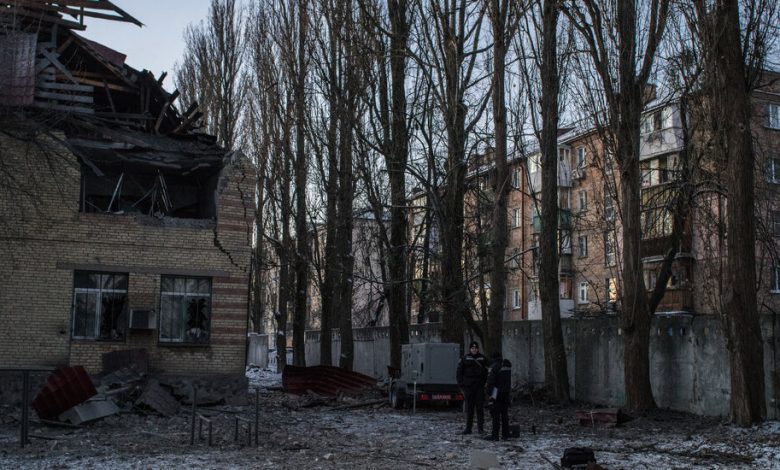Russia Launches a Wave of Iranian-Made Drones at Kyiv After a Lull

KYIV, Ukraine — Russia launched a swarm of Iranian-made explosive drones at Kyiv on Wednesday, the second such assault on Ukraine in a few days, ending a three-week lull in attacks with waves of drones.
Ukrainian officials and military experts have said the pause in using drones — even as Russians continued to attack with missiles — could mean the devices were malfunctioning in Ukraine’s damp, subfreezing weather. The attack on Wednesday suggested that if there was such a glitch, it had been fixed.
Ukraine’s air defenses shot down all 13 of the Iranian-made Shahed drones — designed to dive into their targets and detonate on contact — that were launched at Kyiv and the surrounding region, officials said. There were no reports of casualties, but falling debris damaged two government buildings and at least four houses, they said.
President Volodymyr Zelensky of Ukraine praised the air-defense systems in a brief video message published on the Telegram messaging app. “Well done! I’m proud!” Mr. Zelensky said. “We thank the Air Defense Forces!”
Compared to missiles, drones are much slower and easier to shoot down. They carry smaller warheads, often have shorter ranges and are less precise, but there has been speculation that Russia is running low on precision-guided missiles. Drones are also far cheaper, allowing an army to fire them by the dozens or even the hundreds, overwhelming air defenses and allowing some to reach their targets.
How long Russian can sustain firing salvos of drones remains unclear. Kyrylo Budanov, Ukraine’s chief of military intelligence, said in October that Russia had ordered about 1,700 drones of all types from Iran and had used more than 300 of them, but it was not clear how fast they were being delivered.
“Shahed terror may actually last for a while,” he said at the time in an interview with Ukrainian news media. But since then, Kyiv has not offered any update on the size of Russia’s arsenal.
On Wednesday, one of the drones shot down over Kyiv bore a message painted on its wing: “For Ryazan!!!” apparently a claim that the attack was revenge for Ukrainian strikes last week at air bases deep inside Russia, including one near Ryazan, south of Moscow, that reportedly killed three service members. Russian warplanes taking off from those bases have fired missiles into Ukraine.
After Russian forces in September began to lose ground they had seized early this year in eastern and southern Ukraine, they drastically increased missile and drone attacks on Ukraine’s civilian infrastructure, particularly the electrical grid, far behind the front lines. Millions of Ukrainians are living and working in subfreezing weather with intermittent power, heat and running water — or none at all — and in damaged buildings ripped open to the elements.
The State of the War
- Patriot Missiles: The United States appears poised to send its most advanced ground-based air defense system to Ukraine, in response to Kyiv’s urgent request for help in defending itself against Russia’s aerial onslaught.
- The Next Front?: Using missiles and saboteurs, Ukraine is focusing on the strategically important city of Melitopol, ahead of an expected Ukrainian offensive to drive Russian forces from southern Ukraine.
- Aid for Ukraine: World leaders announced more than $1 billion in swift aid for Ukraine to repair vital infrastructure and survive what is already a brutal winter.
- Avoiding Questions: President Vladimir V. Putin will not hold his annual December news conference. The move comes as Russia’s economy falters and follows a series of military setbacks in Ukraine.
The United Nations and human rights groups have said repeatedly that such strikes on civilian targets can constitute a war crime.
The renewed drone strikes come amid rising concerns Russia could also acquire Iranian ballistic missiles. Ukraine now has no defenses against such missiles. The United States is expected as early as this week to announce a transfer to Ukraine of Patriot air-defense missiles, which are designed to shoot down missiles, which would be the most sophisticated weapon provided to Ukraine over 10 months of war.
The Biden administration has been reluctant to provide the most advanced arms to Ukraine, especially those that could be used to strike far into Russia, fearing anything that could cause the war to escalate into direct confrontation with Moscow. Ukraine’s recent attacks on air bases some 300 miles beyond its borders were carried out using Soviet-era reconnaissance drones, possibly repurposed with warheads, military analysts have suggested.
The Kremlin spokesman, Dmitri S. Peskov, said on Wednesday that Russia would “undoubtedly” target any Patriot missile batteries in Ukraine. But Moscow has made similar statements about other sophisticated weapons supplied to Ukraine, like the highly effective HIMARS rocket artillery, warning repeatedly that it saw their arrival as escalations.
In addition to weapons, the United States and its allies have provided humanitarian aid and financial backing to Ukraine, and in recent days have focused on efforts to rebuild critical infrastructure. The European Parliament on Wednesday approved a $19 billion loan package
Pope Francis on Wednesday suggested that people celebrate “a more humble Christmas” this year by spending less on gifts and celebrations and sending the difference to Ukrainians in need.
In justifying striking Ukrainian civilian targets, Russia has stirred dark themes of revenge that do not fit the real timeline of the war. President Vladimir V. Putin said last week that Moscow’s attacks were retaliation for an explosion in October that damaged the Kerch Strait bridge, a symbolically and strategically important span tying Russian-occupied Crimea to Russian territory. But there have been Russian assaults on civilian targets throughout the war, and the wave of strikes on Ukrainian power plants began in September.
The words painted on a Russian drone on Wednesday continued in that vein. And a message visible from satellites was written recently on the runway of Russia’s Engels air base, used by bombers that launch cruise missiles at Ukraine, saying, “Death to Nazis,” an apparent response to a Ukrainian drone strike there on Dec. 5.
The Ukrainian government does not publicly acknowledge attacks inside Russia under a policy of intentional ambiguity. But it has been open about developing long-range drones, and Ukrainians have cheered such attacks as payback.
But a former defense minister, Andriy Zagorodnyuk, dismissed the idea of Russian attacks as retaliation, in part because of the asymmetry between Ukrainian strikes on targets that are overtly military or have direct military value, and Russia’s assaults on targets that do not and are meant only to degrade civilian life. And no matter what Ukraine does, he said, its leaders believe that Mr. Putin will continue the war regardless.
If Ukraine hit the Russian air bases, he said — insisting that he could not say whether it had or not — the goal was to chip away at Russia’s capacity to launch cruise missiles at Ukraine.
When small, Iranian-made exploding drones first appeared on Ukrainian battlefields in August, it was their first known use outside the Middle East. Russia has since fired flurries at Ukrainian cities and the country’s electrical grid and power stations, but paused such attacks in November, as winter weather set in. With little information on the rate of delivery from Iran, there have been questions about whether the Russia’s supply of drones had run low.
The Institute for the Study of War, a United States-based research group, on Dec. 7 cited comments by Ukrainian officials suggesting that the drones — made for a warmer, arid climate — had been susceptible to the damp, freezing conditions in Ukraine, but that Russian engineers had resolved the problem.
A salvo of Iranian-made Shahed-136 drones fired over the weekend at Odesa was the first in three weeks to hit Ukraine. But some uncertainty about the weapon’s compatibility with colder weather lingered. Natalia Humeniuk, a spokeswoman for Ukraine’s southern military command, noted on Sunday that the flurry had coincided with above-freezing weather.
“The Russians tried to adjust them to the weather conditions,” she said. Ms. Humeniuk said the drones were vulnerable to the formation of ice on their wings or flight-control surfaces. “They were most concerned about aerodynamics, the possibility of icing in case of temperature changes,” she said.
But in Kyiv on Wednesday, it was 23 degrees Fahrenheit, well below freezing, when the sun rose in a partly overcast sky.
The lull in drone waves also prompted military analysts to raise questions about whether Russia might be running low. Mr. Budanov, the military intelligence chief, said in October that some of those ordered from Iran had not yet been manufactured.
The war in Ukraine has been a sort of beta test for aerial drone combat, carefully watched by militaries and developers around the world. The Shahed-136, with an 80-pound warhead, can be fired in swarms from a flatbed truck. It is among dozens of types of drones being used in Ukraine.
The United States has supplied Ukraine with its Switchblade drones that, like the Shahed, are essentially flying bombs that self-destruct. Ukraine has also deployed Turkish-made Bayraktar TB2 drones that fire guided missiles. Russia has lagged for years in drone development and does not have a domestically produced long-range strike drone.
The drones aimed at Kyiv on Wednesday were launched from the Sea of Azov, more than 350 miles to the southeast, Ukrainian officials said.
The first sound that Yaroslav Vinokurov, 24, heard shortly before 6 a.m. was the wailing of the air-raid alarm in the darkness. He continued to get ready for work, given that alarms sound in Kyiv nearly every day. But soon machine-gun fire echoed through the Shevchenkivskyi district as air-defense systems flashed in the sky, followed by what he described as “a very loud explosion.”
“I lay down on the floor, as I didn’t know what else can happen,” Mr. Vinokurov said. Only once it was quiet did he go outside.
The roof of a nearby government building was damaged, and debris littered the area. “My car is destroyed,” he said, surveying the scene.
Residents rushed to put sheets, blankets and whatever else they could find over shattered windows to protect themselves from the bitter cold.
Maria Varenikova, Victoria Kim and Elisabetta Povoledo contributed reporting.





